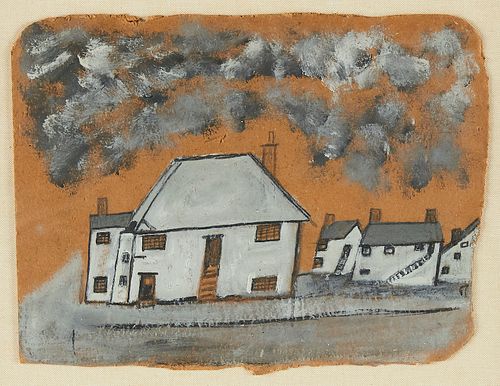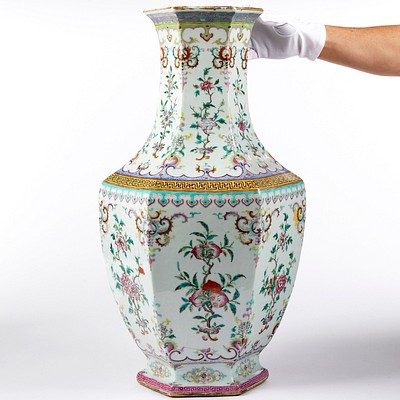Alfred Wallis "The White House" Painting on Board
About Seller
755 Prior Ave N, #235C
St. Paul, MN 55104
United States
Revere Auctions is a premier auction house located in Saint Paul, Minnesota.
Two ways to bid:
- Leave a max absentee bid and the platform will bid on your behalf up to your maximum bid during the live auction.
- Bid live during the auction and your bids will be submitted real-time to the auctioneer.
Bid Increments
| Price | Bid Increment |
|---|---|
| $0 | $25 |
| $300 | $50 |
| $1,000 | $100 |
| $3,000 | $200 |
| $7,000 | $500 |
| $10,000 | $1,000 |
| $20,000 | $2,000 |
| $50,000 | $5,000 |
| $100,000 | $10,000 |
| $500,000 | $25,000 |
| $1,000,000 | $50,000 |
| $10,000,000 | $100,000 |
About Auction
Dec 11, 2020
A notable collection of rare historical books and modern first editions, sold together with a variety of fine art and antiques, including Asian Art, modern prints and posters, mid-century modern furniture, Civil War memorabilia, knives, and more. Revere Auctions info@revereauctions.com
- Lot Description
Alfred Wallis (1855-1942). Pencil and gouache on cardboard drawing titled "The White House." Gallery and museum label attached on the verso. Unsigned. Provenance: Crane Kalman Gallery, London UK Private Collection, Cambridge, MA Exhibition: Dublin, Irish Museum of Modern Art, Two Painters: Alfred Wallis & James Dixon, 1999-2000, with tour to Tate St Ives. Exhibition number WD68. Alfred Wallis (18 August 1855 - 29 August 1942) was a Cornish fisherman and artist. Wallis's parents, Charles and Jane Wallis were from Penzance in Cornwall and moved to Devonport, Devon to find work in 1850 where Alfred and his brother Charles were born. Shortly after this the children's mother died and this prompted the family to move back to Penzance. On leaving school Alfred became an apprentice basket maker before becoming a mariner in the merchant service by the early 1870s. This work involved sailing schooners across the North Atlantic between Penzance and Newfoundland. Alfred married Susan Ward at St. Mary's church in Penzance in 1876, when he was 20 and his wife was 41 and became stepfather to her five children. He continued his life as a deep-sea fisherman on the Newfoundland run in the early days of his marriage allowing him to earn a good wage until the death of his two infant children when Alfred switched to local fishing and laboring in Penzance. The family moved to St. Ives, Cornwall, in 1890 where he established himself as a marine stores dealer, buying scrap iron, sails, rope and other items. In 1912, his business, "Wallis, Alfred, Marine Stores Dealer" closed for business and Alfred kept himself busy with odd jobs and worked for a local antiques dealer Mr Armour which provided some insight into the world of objets d'art. Following his wife's death in 1922, Wallis took up painting, as he later told Jim Ede, "for company". His paintings are an excellent example of naïve art; perspective is ignored and an object's scale is often based on its relative importance in the scene. This gives many of his paintings a map-like quality. Wallis painted his seascapes from memory, in large part because the world of sail he knew was being replaced by steamships. As he himself put it, his subjects were "what use To Bee out of my memery what we may never see again... "Having little money, Wallis improvised with materials, mostly painting on cardboard ripped from packing boxes using a limited palette of paint bought from ships' chandlers. In many ways, Wallis' timing was excellent. In 1928, a few years after he had started painting, Ben Nicholson and Kit Wood came to St. Ives and established an artist colony. They were delighted to find Wallis and celebrated his direct approach to image-making.(Nicholson commented later 'to Wallis,his paintings were never paintings but actual events') Wallis was propelled into a circle of the some of most progressive artists working in Britain in the 1930s. The influence, however, was all one way; Wallis continued to paint as he always had.) Nicholson later said of Wallis's art 'something that has grown out of the Cornish seas and earth and which will endure') Through Nicholson and Wood, Wallis was introduced to Jim Ede who promoted his work in London. Despite this attention, Wallis sold few of his paintings and continued to live in poverty until he died in the Madron Workhouse in Penzance. He is buried in Barnoon cemetery, overlooking St. Ives' Porthmeor beach and the Tate St Ives gallery. An elaborate gravestone, depicting a tiny mariner at the foot of a huge lighthouse - a popular motif in Wallis' paintings - was made from tiles by the potter Bernard Leach and now covers Wallis' tomb. Source WikipediaPlease contact us for a condition report
Condition
- Shipping Info
-
Shipping As a convenience to the Buyer, Revere Auctions will make a referral for packing and shipping. This is at the request, expense, and risk of the Buyer, and Revere Auctions assumes no responsibility for the items or the timing of delivery. Insurance for in transit items is the responsibility of the buyer. See below for preferred shippers: UPS Store #2105 Contact: Ryan Wilson 651-642-5972 store2105@theupsstore.com UPS Store #2158 651-635-0636 store2158@theupsstore.com UPS Store #5396 Contact: Emily 612-332-4117 store5396@theupsstore.com Museum Services, Inc. For shipping estimates please visit the following link: https://museumservices.org/revere Museum Services, Inc. is best suited for shipment of items that are large, very fragile, and/or difficult to pack. For small items valued under $500, other carriers may be more economical. Estimates for pre-sale are $35.
-
- Buyer's Premium



 EUR
EUR CAD
CAD AUD
AUD GBP
GBP MXN
MXN HKD
HKD CNY
CNY MYR
MYR SEK
SEK SGD
SGD CHF
CHF THB
THB













